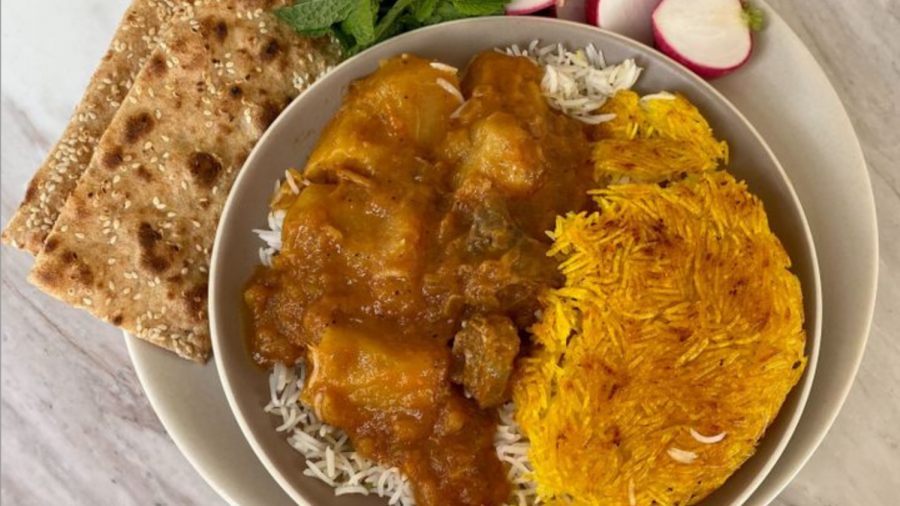A Persian meat and apple stew for Rosh Hashanah
Published August 29, 2021
When I was in elementary school, my family visited my cousin Rashel at her home in Maryland, and everything about the trip felt new.
Rashel’s teenage daughters seemed so cool and confident, Rashel herself so relaxed and casual in her parenting style. I marveled at the rushing waters of the Potomac River and their seemingly endless backyard covered in a lush carpet of grass grown wild – all so far from the drought-ridden Los Angeles suburb I called home.
But what stays with me most from that trip is a meal.
ADVERTISEMENT
One night for dinner, Rashel picked apples from the tree in their front yard to make a dish I’d never had before. Of course the form factor was familiar: khoresh is foundational in Persian cuisine, a long-cooked stew served over steamed basmati rice. Some flavors of khoresh feature fresh greens and herbs, others fresh or dried fruit. Khoresh has meat, but it’s the fruit or vegetables that shine in this dish, combining to form the sour flavor profile that Persians love.
Rashel’s creation looked similar to khoreshte beh, a tomato-based khoresh with sweet fried quince. But instead of quince, it featured pale, buoyant wedges of apple. The flavors of this khoreshte sib, apple khoresh, were a little lighter than khoreshte beh. The apples were not as dense as quince, the base, reduced to a sauce-like consistency, was just a bit sweeter and brighter. It felt like a new generation of khoresh, intrepid and mischievous.
I haven’t had this dish since, but I never forgot it. And recently, I finally asked Rashel about it. It turns out she came up with the recipe shortly after she and her then-husband moved to the U.S. in 1963, over a decade before the rest of our family would start migrating to this country.
Longing for the tastes of home, but unable to find quince here at the time, she adapted the khoresh model to what was available locally. She started with the traditional step of browning meat with turmeric and chopped onions until they grew soft, golden, and sweet, adding a tiny pinch of saffron for its unparalleled fragrance. But she fleshed out her khoresh with apples, added a puree of summer stone fruit to the base to balance the apples’ sweetness with their tartness, and finished off the dish with a sprinkle of dried mint.
ADVERTISEMENT
To me, Rashel’s khoreshte sib is a perfect Rosh Hashanah recipe: not only does it feature the traditional apples, but by joining them with stone fruit, this dish marks the exact seasonal intersection of summer and fall where the holiday sits. And beyond the seasonality of this dish’s ingredients, its intent feels right for this moment, too. As we cross the threshold of another year, steeped in uncertainty, surrounded by unknowns, I carry with me the lesson I learned from Rashel: when there’s no path, when the terrain is unfamiliar, trust your instincts, find the good in what’s around you, start with what you know, and create your own comfort.
Khoreshte sib, Persian meat and apple stew
Ingredients
½ lb. boneless lamb, veal, or beef shank meat, cut into 1-inch squares and trimmed of excess fat
4-6 tart stone fruits, a mix of plums, apricots, peaches, or nectarines
Salt and pepper
3 tbs neutral oil, such as grapeseed, divided
2 sweet apples, such as fuji or golden delicious, peeled, cored and cut into 4 wedges each, about 1 pound total
½ large onion, chopped finely
1 tbs dried turmeric
Pinch of ground saffron
6 tbs Tomato paste
2-4 tbs verjus (sour grape juice) or lemon juice
1 teaspoon dried mint
Instructions
1. If your meat is not kosher, salt thoroughly and set aside.
2. Peel stone fruit. Cut a small X into the end of each fruit and place in a bowl of boiling water for about five minutes. Remove fruits from the bowl, and when they are cool enough to handle, peel and place flesh in a blender, discarding pits. Puree until fully mixed and no lumps remain. You should have about 1 ½ cups of puree. Set aside.
3. Add 1 tablespoon oil to a large, heavy pot or Dutch oven over medium high heat. Saute apples until golden brown on all sides, turning pieces occasionally, about 8 minutes. Remove from pot and set aside.
4. Add remaining 2 tablespoons of oil to pot over medium high heat. Add onion, turmeric, saffron, ¼ teaspoon salt, ¼ teaspoon pepper, and meat, and stir to combine all ingredients. Fry, stirring occasionally, until meat is cooked on all sides and onions start to gently brown and soften, about 10 to 12 minutes.
5. Add tomato paste, stir to combine, and cook for 2 more minutes.
6. Add fruit puree and 3 cups of water to the meat and onion mixture. Stir, bring to a boil, then lower heat and simmer, covered, for 30 minutes. Add apples, and continue simmering covered for another 20 minutes, or until apples are cooked through. Remove lid, bring khoresh back to a boil, and cook until liquid is reduced to the consistency of a rich sauce, 5 to 10 minutes.
7. Taste dish and adjust acid by adding verjus or lemon juice until the dish is a delicious balance of sweet and sour. Adjust salt and pepper, add dried mint, and stir to combine thoroughly.
This article originally appeared at forward.com. Reposted with permission.



















